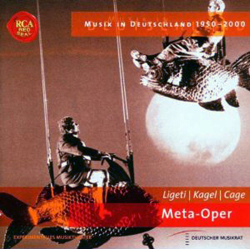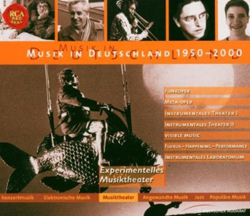| ← Back to Works Index | |||
|
Work Title Europeras 1 & 2 |
|||
|
Alt. Title Europeras 1/2 |
|
Alt. Title Europeras 1 and 2 |
|
Date Composed between 1985 and 1987. Premiered in Frankfurt am Main, December 12, 1987. |
|
Ensemble Type Opera |
|
Work Length 135 minutes |
|
Instrumentation For any number of voices, chamber orchestra, tape, and organ ad libitum. Soloists, 3 (2Piccs) 3 (2EUs) 3 (Bcl)2 22 (C) 31 I, Perc (1), Str (single players), Tape (Org) |
|
Comments Europeras 1 & 2 derives its name from the words "Europe" and "opera," suggesting the work's content and sounding like "Your opera," alluding to the work's populist leanings. The "1 & 2" of its title denotes two, unequal parts -- one 90 minutes in length, one 45 -- which are separated by a 1'50" looping black and white film of chance-derived moments from both developed, to Cage's specifications, by Frank Scheffer. Europeras 1 & 2 is, like all of Cage's work since the early 1950s, conceived wholly of chance operations. The chance operations employed, however, are of unprecedented sophistication even for Cage, due to the use of high-speed computer technology to run "IC," a stand-alone computer (software) program specially designed by Andrew Culver to simulate the coin oracle of the I Ching. The work's musical "content" is the simultaneous presentation of arias and duets heard against and within a pulverized, decontextualized mass of 1-16 measure instrumental fragments drawn from 64 European operas of the past, all in public domain and ranging from Gluck to Puccini. Its cast of players is, by opera standards, somewhat small: 19 singers, 12 dancer/athletes, and a 24-piece orchestra, without the usual body of strings and with the unusual addition to its percussion section of "Truckera," a tape of 101 layered fragments of European operas mixed live at a 1987 broadcast at New York's WKCR. Its extra-musical elements are those commonly associated with the genre: elaborate lighting cues, costumes, and props, lively and varied stage actions, intermittent dance, and an imaginative, subtly shifting stage décor. For more information on this work and others in the Europeras series, see Stefan Beyst's August 2005 essay John Cage's Europeras: a light- and soundscape as musical manifesto (http://d-sites.net/english/cage.htm), or Laura Kuhn’s comprehensive doctoral dissertation, John Cage’s Europeras 1 & 2: The Musical Means of Revolution (UCLA, 1992). |
|
Publication Peters Edition EP 67100a |

